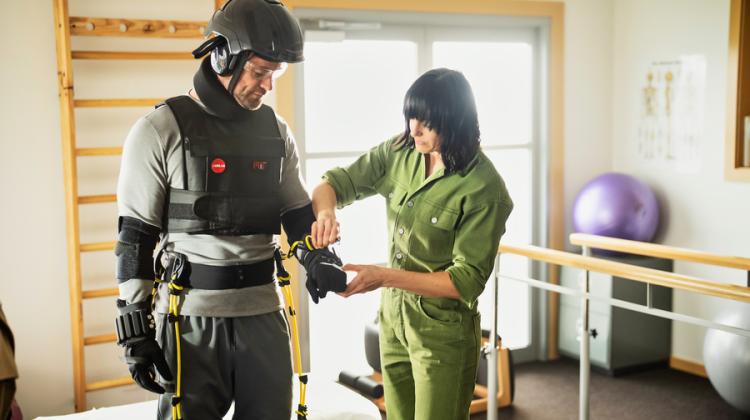A Personal Understanding of the Aging Experience

Chris Hemsworth (left) is outfitted in the MIT AgeLab's AGNES suit on a recent episode of “Limitless With Chris Hemsworth”
Visitors to MIT’s AgeLab in the Center for Transportation and Logistics are greeted silently by a shiny mannequin in a jumpsuit and chunky red goggles, standing a little ominously in a glass-walled studio. While the mannequin itself cuts a striking appearance, it’s the accessories under the jumpsuit that are the real attraction: a collection of weights and bungie cords, some unwieldy gloves, and a pair of Crocs with blocks of foam glued to the bottom of them — as well as the red goggles.
Taken together, these items make up AGNES, which stands for the Age Gain Now Empathy System. AGNES is an empathy and research tool designed by the MIT AgeLab to simulate for the wearer some of what it may feel like to live in one’s early 80s with a few chronic health conditions. The weights approximate muscle loss, the bungies the reduction of range of motion and flexibility that can affect the joints with age. The foam-platform Crocs simulate the erosion of balance, and the heavy, awkward gloves evoke the loss of tactile sensation. Finally, the red goggles simulate a range of impairments to vision, from impaired acuity to diabetic retinopathy.
“The development of AGNES has been a collaborative and iterative effort by MIT researchers and students over time,” says Joe Coughlin, director of the MIT AgeLab. “It began with a neck brace and elastic bands that we used to better understand the challenges of automobile ingress and egress for older users. Today, we use AGNES to give researchers and students a taste of the friction, frustration, and fatigue that older adults often experience.” AGNES is also a key instructional tool in Coughlin’s course 11.547/SCM 287 (Global Aging & The Built Environment).
Putting on AGNES approximates the effect of aging a person in a moment, an experience that is startling, if not overwhelming, for many people. But the suit is not just for shock value. It is used to help designers, engineers, executives, and helping professionals understand a little better the physical and social world as a version of their future self, so that they can design better products and services for older users. AGNES has been used globally to inform the design of public transportation systems, retail environments, medical devices, and product packaging.
Since her debut in 2006, aside from unnerving and instructing MIT students, research sponsors, and visitors, AGNES has ventured into show business, making an appearance with the popular YouTubers “The Try Guys” and playing a prominent role in the PBS documentary “Fast Forward.”
Most recently, AGNES appears in a new documentary series titled “Limitless with Chris Hemsworth,” which is produced by National Geographic and streaming on Disney+. The series is directed by Darren Aronofsky (“Noah,” “Black Swan”) and stars actor Chris Hemsworth.
Most of the six-episode series features Hemsworth braving extreme situations like freezing temperatures, high altitudes, and days of fasting, which serve as avenues to understand — and overcome — the limits of the human body. But the final episode of the documentary takes a surprising turn. Instead of attempting to surmount yet another challenge, Hemsworth is tasked with accepting the unavoidable limits of human potential: the fact that he will get older, that he will physically decline, and that he will die.
The producers of “Limitless” go to surprising lengths to immerse Hemsworth in the world of older age. An entire retirement community, complete with residents and aides, is constructed for Hemsworth to live in. An ID card with an aged version of his face is printed for him to carry on a lanyard. And Hemsworth is outfitted in a custom version of AGNES so that he can experience how his body might change when he gets older.
Early in the episode, Hemsworth complains about wearing AGNES — “this suit sucks, by the way” — and attempts to overcome its limitations by brute effort. He loses a game of ping pong and exhausts himself in an aerobics class. But by the second day of wearing the suit, he realizes that there is no way for him to defy the limits that AGNES brings. Instead, he begins to learn how to adapt to them and finally to accept them, and to allow himself to depend more on other people.
“We often talk about AGNES as an empathy tool, but the suit’s appearances in popular media also suggest its power as a tool for storytelling about increased longevity,” says Taylor Patskanick, a researcher at the MIT AgeLab who is involved in research and organizing workshops using AGNES. The striking appearance of the suit, and the vivid responses that its wearers have to the experience, can prompt surprise, discussion, and reflection in an audience, leading to new forms of understanding.
“I like to say that the story is the oldest technology that we have. Stories engage us, instruct us, and give us a sense of what’s possible,” says Coughlin. “AGNES is not necessarily destiny, but it does provide users and observers with insights into what their older self might be. It’s an opportunity for us to imagine our future today so that we might have a better life tomorrow.”


